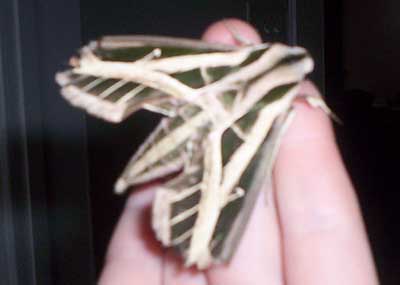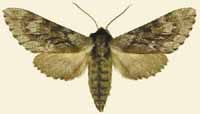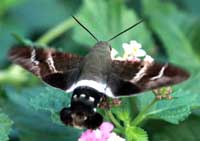Waseca County, Minnesota
Sphingidae

Eumorpha fasciatus (rare stray),
Waseca County,
October 19, 2007 courtesy of Roxanne Goodrich.
This page is inspired by and dedicated to Roxanne
Goodrich who sent me the image of the Eumorpha fasciatus moth
from Waseca County, October 19, 2007, as depicted at the
top of this page. Roxane writes,
"My boys and I really enjoyed
your site. We found a Vine Sphinx Moth last night. We are in
Southern Minnesota. How rare is it for us to find one this far north?
Anything we should do?"
In her intial email there was no picture attached and I wrote back,
"Roxanne,
"I do not think the Vine Sphinx (Eumorpha vitis) is known to
fly in Minnesota, especially this late in the season.
I think it is more likely that you have seen Hyles lineata. My
Sphingidae of Minnesota page is at
http://www.silkmoths.bizland.com/MNsphinx.htm.
I am also not sure if you have seen a moth or are referring to a caterpillar.
If you could send me an electronic image, that would be super. What
was the moth doing when you saw it?
"Sometimes in the fall, the migrating Sphinx species ride strong
southerly winds and up in the more northerly states so I cannot rule
out the possibility that you did indeed see a vine sphinx.
"Glad you are enjoying the site. Thanks for thinking of me."
Roxanne subsequently sent the images that let me identify the moth
as Eumorpha fasciatus which is very similar in appearance to
the Vine Sphinx. As far as I know, this is the first time E. fasciatus
has been reported in Minnesota, and it probably does not reproduce there,
occuring only as a rare stray.
Only twelve Sphingidae species are listed for Minnesota on the U.S.G.S.
website. None of the species are reported in
Waseca County. It is hoped that this checklist, with the thumbnails
and notes, will help you quickly identify the moths you are likely to
encounter.
A "WO" after the species name indicates that
I have no confirmed reports of this species in your county, but I
(William Oehlke) expect that this moth is present or
might be present. I have included many species not on the
USGS list for Minnesota; I believe they are or might be present
A "USGS" indicates the
moth is reported in Lepidoptera of North America,
#1. Distribution of Silkmoths (Saturniidae) and Hawkmoths (Sphingidae)
of Eastern North America,
an excellent little booklet available through Paul Opler.
Please help me develop this list with improved, documented accuracy by
sending sightings (species, date, location), preferably with an
electronic image, via email to
Bill Oehlke.
Sphinginae subfamily
Sphingini tribe:
 |
Ceratomia amyntor
WO,
the Elm Sphinx or Four-horned Sphinx
The upperside of the forewing is brown with dark brown and white
markings including a white costal area near the wing base, dark
streaks along the veins, and a white spot in the cell. The upperside
of the hindwing is light brown and has a dark brown band along the
outer margin.
|
 |
The upperside of the forewing is pale brownish gray with wavy black
and white lines and a black-outlined white cell spot. The upperside
of the hindwing is gray with diffuse darker bands.
|
 |
The upperside of the forewing is gray with heavy black bands. The
upperside of the hindwing is brownish gray with no markings.
|
 |
Manduca quinquemaculata
WO the Five-spotted Hawkmoth.
The moth abdomen usually has five but sometimes six pairs of yellow
bands. The upperside of the forewing is blurry brown and gray. The
upperside of the hindwing is banded with brown and white and has two
well-separated median zigzag bands.
|
 |
Sphinx chersis
WO, the Northern Ash Sphinx or Great Ash
Sphinx
Larval hosts are ash, lilac, privet, cherry, and quaking aspen.
|
 |
This species is not officially recorded, but it may be present. We
have them on P.E.I., but I do not see them frequently.
unlikely |
 |
If you have blueberries in the woods, then you might have the Poecila
Sphinx. They are pretty common here on Prince Edward Island, but
don't fly too far west of Wisconsin. |
Smerinthini Tribe:
 |
This moth is also fairly widely reported to the east and south
and might be present.
This is the first Sphinx species I reared as a boy in New Jersey.
See the file for the female; she is different. |
 |
This moth is found in Canada and states east, south and west of
Washington County, Minnesota,
so it is probably present in Waseca Co., too. |
 |
Named for the dull grey-blue spot in the hindwing, this moth has a
wide distribution and is possibly present in Waseca County.
I regularly see them on Prince Edward Island. |
 |
Named for the small eye-spot in the hindwing, this moth has a wide
distribution and is probably in Waseca County.
I regularly see them on Prince Edward Island, and they are reported
as far south as Florida.
|
 |
At my home in Montague, P.E.I., Canada, they are quite common.
This is a very easy species to rear. |
 |
Smerinthus jamaicensis closely resembles Smerinthus cerisyi,
but jamaicensis is much smaller with larger blue patches on
more vibrant and deeper purple in the lower wings. |
Macroglossinae subfamily
Dilophonotini tribe:
 |
The body is dark brown with a wide white stripe across the abdomen.
The wings are dark brown. The upperside of the hindwing has
pale patches along the costa and inner margin.
rare summer/fall stray |
 |
The abdomen has very distinct gray and black bands.
Adults nectar at dusk so you may see them in the garden at that time.
probably only as a stray
|
 |
Hemaris thysbe
WO, the Hummingbird Clearwing
This interesting day flier is not confirmed for your county.
They are widely distributed in the east from P.E.I. to Florida.
|
 |
Hemaris diffinis
WO, the Snowberry Clearwing or Bumblebee
Moth
This moth is widely distributed but is not confirmed
for Waseca County.
|
Philampelini tribe:
 |
Larvae get large and feed on grape vines and Virginia creeper.
|
 |
Eumorpha fasciatus
RG, the Banded Sphinx
The upperside of the moth is dark pinkish brown. Each forewing has a
lighter brown band along the costa, and sharp pinkish white bands and
streaks. Larvae feed upon primrose-willow, Ludwigia (water primrose)
and other plants in the evening primrose family.
rare stray into Minnesota.
|
Macroglossini tribe:
 |
Darapsa myron
WO, the Virginia Creeper Sphinx or the
Grapevine Sphinx
The forewing upperside is dark brown to pale yellowish gray, with an
olive tint.
On the costal margin there is a dark rectangular patch, although this
may be reduced or absent. The upperside of the hindwing is pale
orange.
|
 |
Hyles gallii WO, the Bedstraw Hawk Moth
or Gallium Sphinx
This species is not reported in Minnesota, but I expect it is present.
Some years I see them on P.E.I., some years, I do not.
|
 |
Hyles lineata
WO,
the White-lined Sphinx
The forewing upperside is dark olive brown with paler brown along the
costa and outer margin, a narrow tan band running from the wing tip
to the base, and white streaks along the veins. |
|
|
Use your browser "Back" button to return to the previous page.
This page is brought to you by
Bill Oehlke and the
WLSS. Pages are on space rented from Bizland. If you would like
to become a "Patron of the Sphingidae Site", contact Bill.
Please send sightings/images to Bill. I will do my best to respond to
requests for identification help.






















